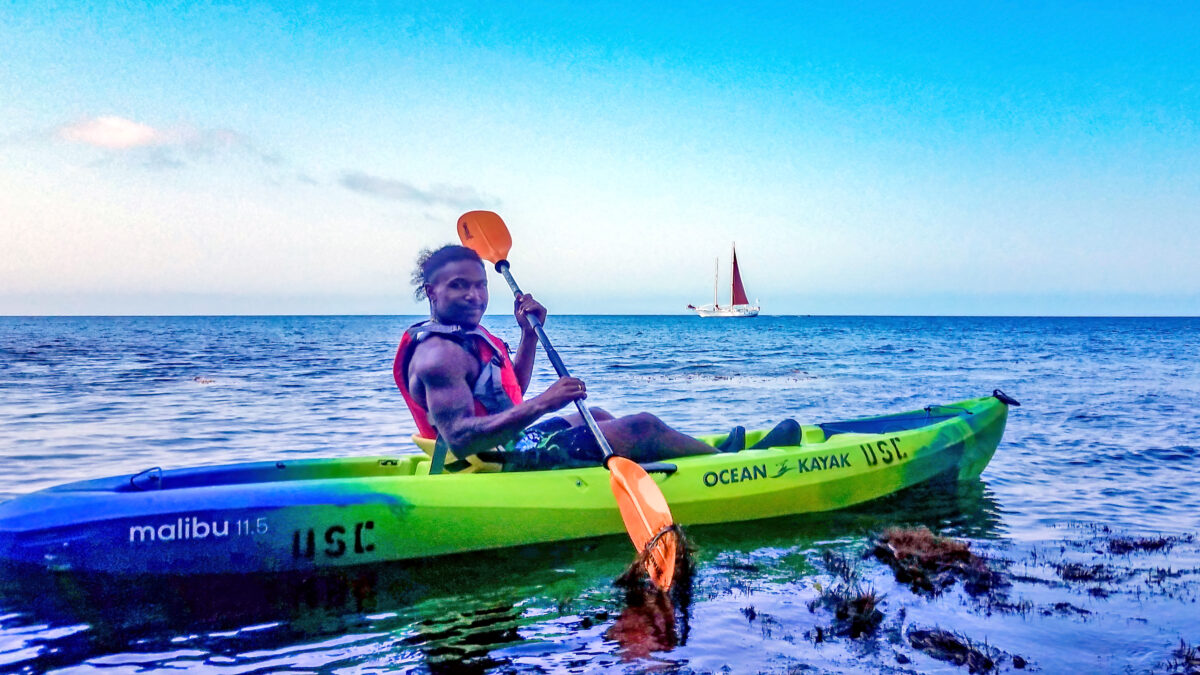
Catalina Island and the Chamber of Recompression
A quintessential part of the Rolex Scholarship is learning as much as you possibly can from people that generally have some connection to the underwater world. As one of the largest coastal states, it’s undeniable that California is a premier place in the U.S. to find that connection, as there is an overt saturation of water-related activities, social involvement, and educational opportunities. Still, while the state is extremely vast and admired along its coasts for its different marine related endeavors, so far I’ve not witnessed a more revered place that emphasizes that coastal connection than Catalina Island. For most folks from California or the west coast, it seemed to me that if you were interested in anything water related, going to Catalina Island was almost a rite of passage. I have already run into so many people from the west who have been there dozens of times, if not at least once or twice in their lives. However, for those hailing from other parts of the country, the idea of spending time on a beautiful island off the coast of California learning more about diving and the pacific waters would be a novel and exciting experience to be had… and to be honest, that’s exactly what it was for me.
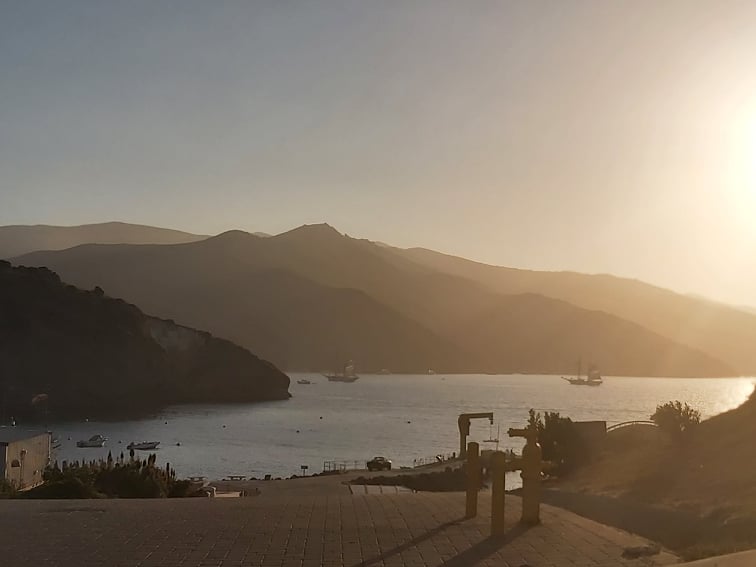
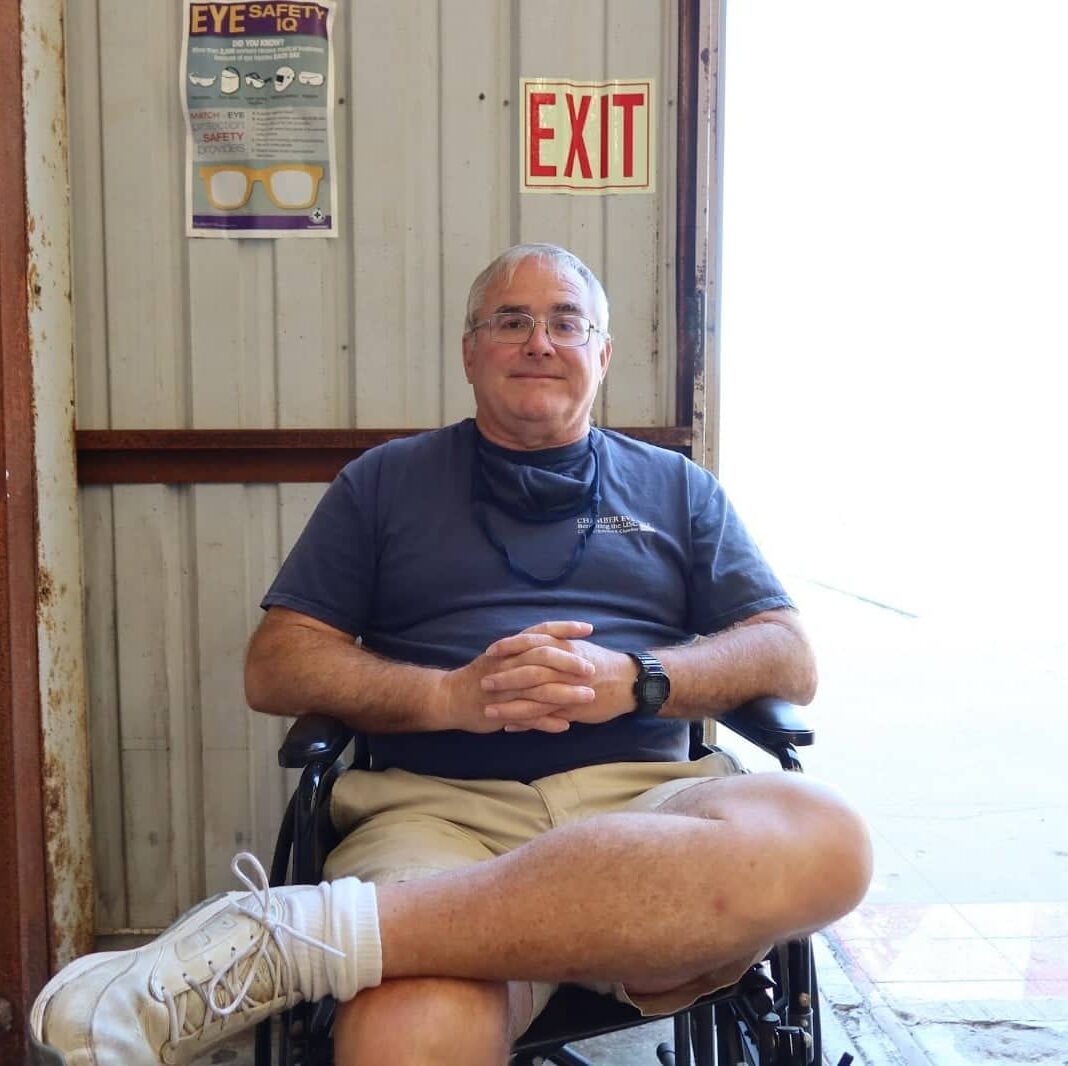
I’m so thankful that during my travels wandering up the west coast, I was invited to visit the USC Wrigley Institute for Environmental Studies on Catalina by the legendary Karl Huggins. Karl, who has been a longtime associate of the Our World-Underwater Scholarship Society since the 1980’s, also manages the Hyperbaric Chamber on the island and has been doing so ever since 1992 (My birth year! Woohoo! Sorry Karl!). Karl was an amazing host and is the creator of the Huggy Dive Tables which are internationally recognized no-decompression tables that utilize Doppler ultrasonic bubble detection to determine a guide and rubric for how to conduct safer dives. Karl’s work allowed him to help develop some of the first recreational dive computers, and many of those programs are still used and tested in the chamber to this day. Knowing that I would be visiting such an icon in the diving community and one of the most well-known islands for divers and aquatic researchers alike- I, of course, was more than excited to visit Karl, learn more about the Catalina Hyperbaric Chamber, the island itself, the new dive gear that I’d just received from Aqua Lung and to experience my own official rite of passage to Catalina.
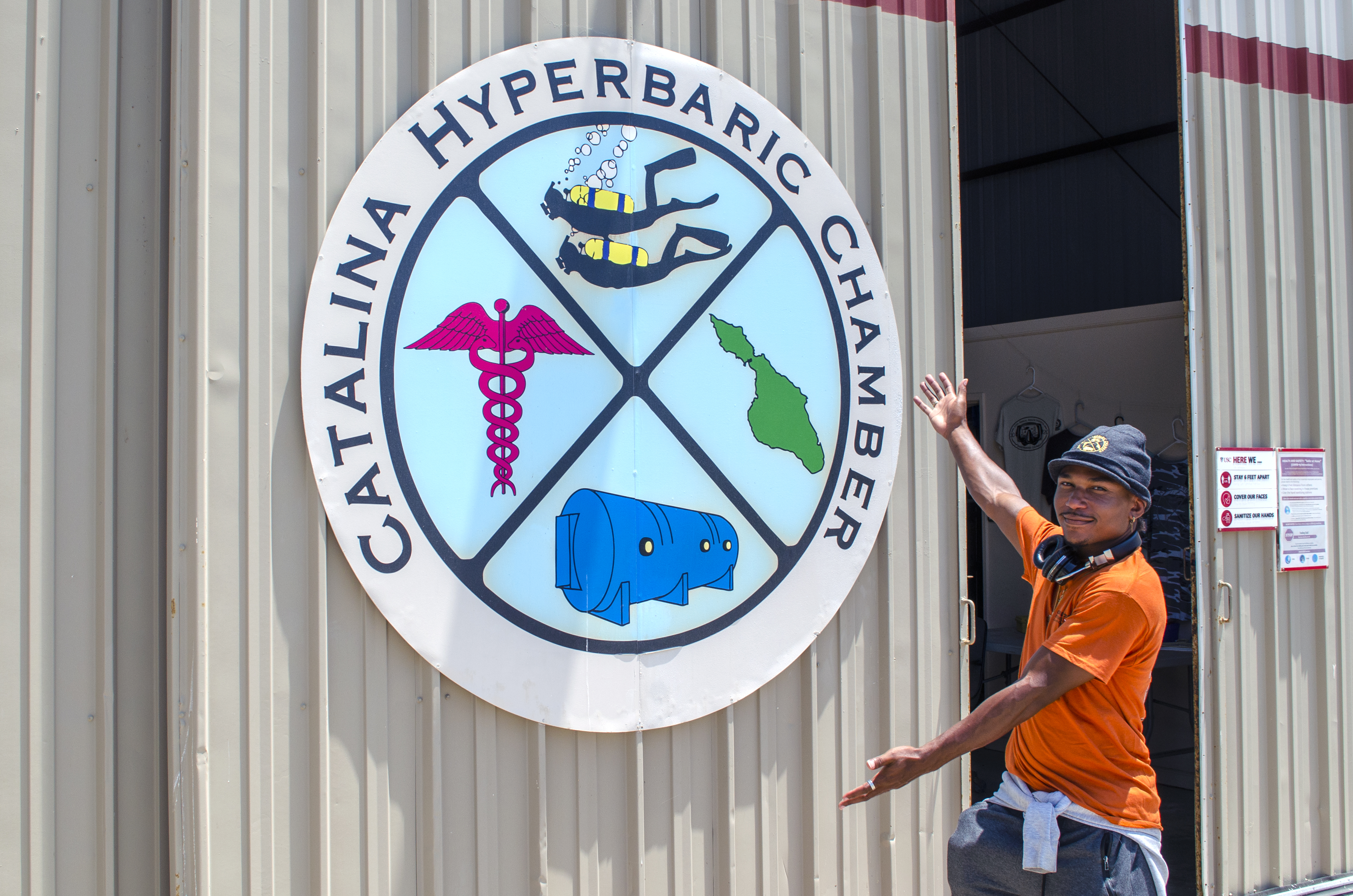
It felt like I was on the Hogwarts Express as I rode into LA on the Californian coastal train for the first time and later took a ferry to the legendary island. My first day on the island was filled with new faces and places. I was to meet up with Karl in the part of the island called Two Harbors. Upon arrival, Karl greeted me and showed me around, pointing out the isthmus from which the area gets its name. Karl also introduced me to some of his coworkers who lived on the more populated part of the island. It was a beautiful place full of verve and excitement, but after a short tour of the place, we headed out towards the research station where most of the real magic happens.
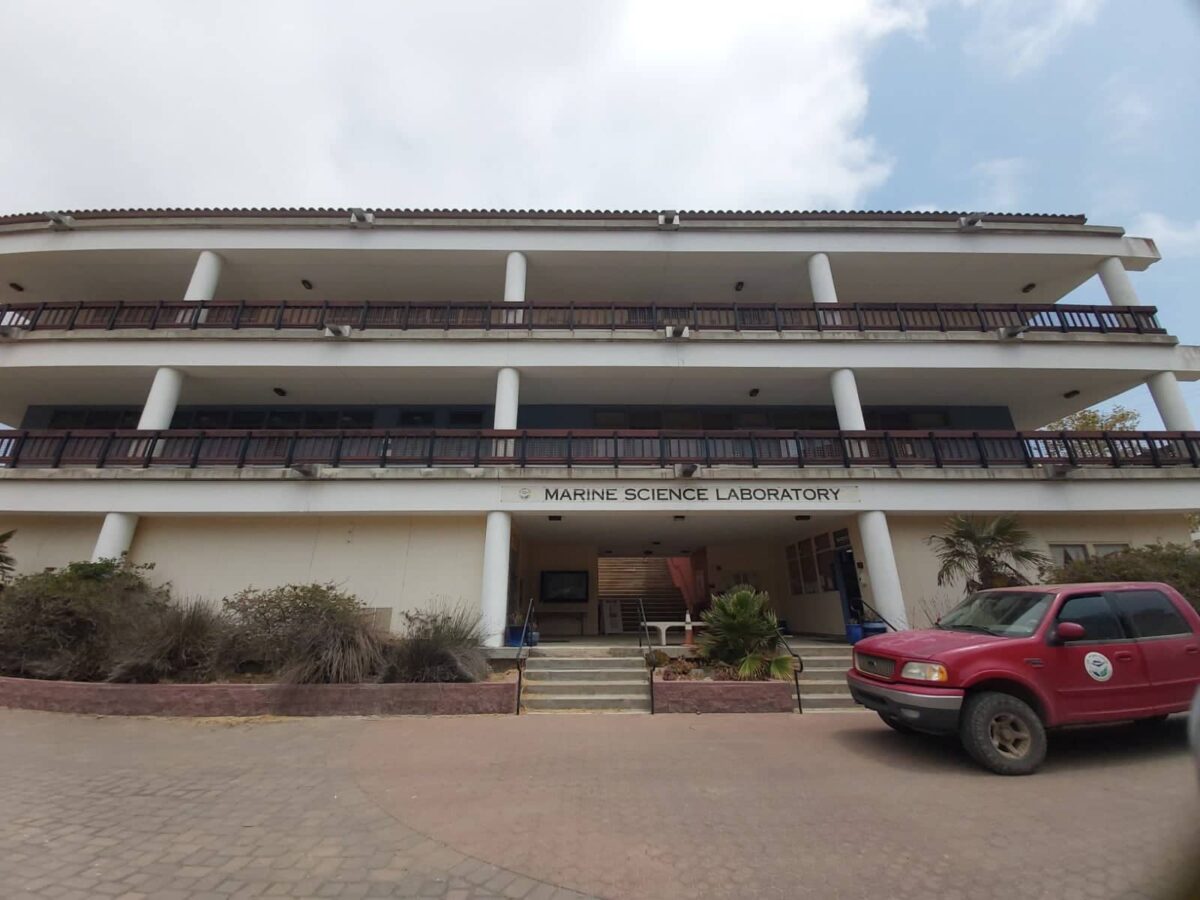
Once the research station came into view over the mountaintop roads, I could see part of the reason it was such a staple for researchers, as it was surrounded by beautiful rustic peaks and the salty spray of the sea. Upon arrival, Karl once again showed me around. It was truly a fascinating place. The entire site seemed to be positioned over a stretch of three steep hills with somewhat drastically different altitudes. In fact, traveling from one building to another could be quite treacherous. One had to either be very careful going down for fear of gravity taking control or conserve enough energy for the exhausting return journey uphill. During Karl’s tour he let me know that the top of these hills was where the dorms were, and where I would be staying. On that same hill, Karl showed me where the lunchroom, guest rooms and staff room were. We then went down to the second highest point where he showed me the administrative building which lies across from the labs. Karl explained that the administrative building was where the staff mostly ran and processed the logistical aspects of the station while the lab was where incoming students and researchers conducted experiments. Karl then took me to the bottom part of the station which was where the boat dock, helipad, dive lockers, kayaks, and perhaps most importantly, the hyperbaric chamber were located and where I would find myself spending a lot of my time.
As we walked around, Karl introduced me to all of the different people we ran into along the way. The people who made up the station were mainly composed of research students (mostly from California universities), the wonderful staff members like Karl who kept the place running, and volunteers helping to man the hyperbaric chamber. Even with my simplistic breakdown and all the Covid restrictions limiting the amount of people on the site, I was surprised to find as many people there as I did. I could barely remember all their names. That would change soon, as nothing quite breaks the ice or helps you learn more about those around you like a good (or bad) dive together.

One of my first and more profound interactions with some of the volunteers and research students
happened on a dive my first day at the research station. I met Tom Carr, who used to work for the police
in search and rescue dive operations, and who was currently there as a volunteer. Tom was going to be
conducting a checkout night dive for a new student who had arrived, named Kristina, and he invited me
and some other student researchers along for the ride. Since it had been a while since my last dive, I was
geeked and excited to have my first dive experience in Catalina. It would also be my first time using the
gear that was gifted to me by Aqua Lung. While new gear can be exciting, it can also be a challenge
figuring out how to make it work best for you, and this time was no different. Upon Kristina’s arrival we
waded into the water and before I knew it, I was having a slew of issues getting my fins on over my
booties and realizing just a bit too late that I was somewhat underweighted. Still, despite my own
issues, I was comforted to know that the people around me were more than willing to help and be
patient as I figured out how to work my new gear. Once my fins were secured and more weights were
added, we went down under the water and had a lovely first dive together. It was not only cool to see
the waters of the island at night (and a little nerve-racking, too, with all the wiggly things attracted to
our dive lights) but it was also awesome to be with such a supportive group of people and because of
that, I knew Catalina Island was going to be one of my most amazing adventures yet.
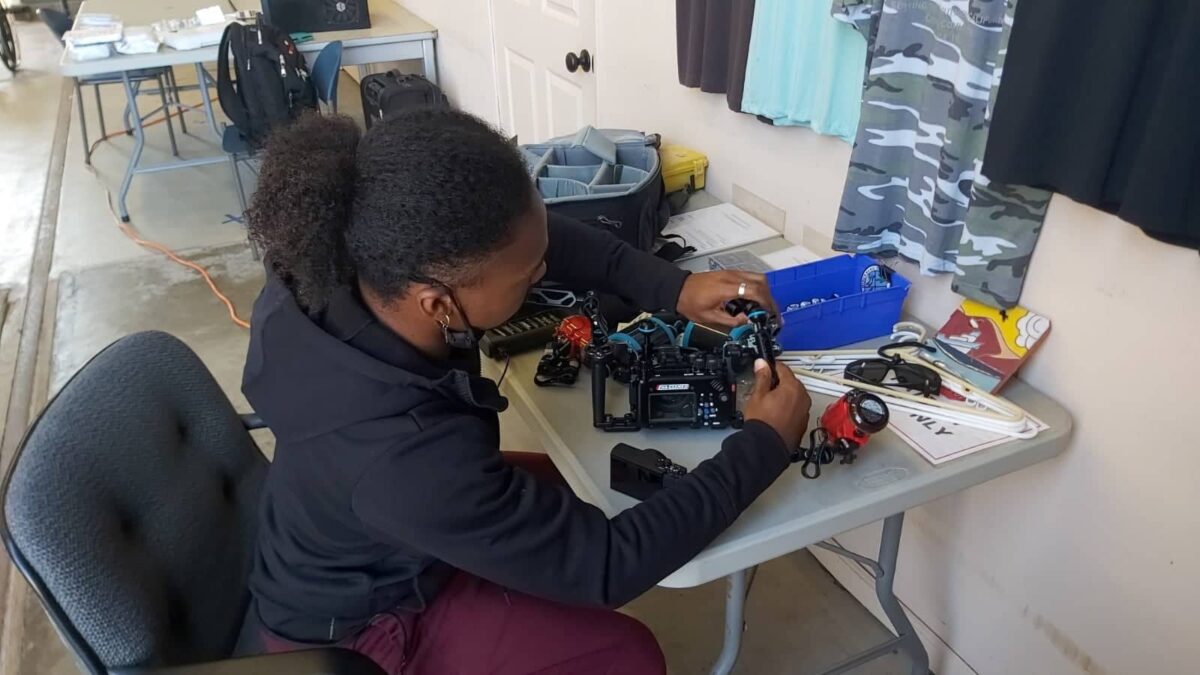

I was proven right as each day that I was there brought a new dimension to my overall educational experience. During my stay I got to talk to more people in depth and began to learn about their roles on and off the island. I spoke with some of the permanent residents to see what their life was like living in such a small but beautiful place. I learned more about the research station and the work that other students were doing. Since octopuses are a main interest of mine, I was very interested in Kristina’s project about interactions between octopuses and morays. I got to know many of thevolunteers, their work outside of Catalina, how each of them got involved helping out with the Chamber. How bittersweet it was, getting to know them, since some would visit only for a day or two! I even learned some more things about my new dive gear. Aside from that, I also had a new underwater camera which I had no idea how to use. With Karl’s help, though, I put it together and figured out how to safely use it. It was awesome. I felt like I was getting to absorb and learn so much.
One particular moment that sticks out in my mind was when I got a text one day from Karl informing me that a Los Angeles County Baywatch helicopter would be coming in for a training landing and that if I wanted to see it that I should come down to the helipad. I don’t know why I was so excited but without hesitation I rolled down the hill to witness the event. While, in retrospect, I suppose nothing that extraordinary happened (the chopper landed and took off) but in that moment there was nothing cooler than to witness up close how these things worked, with my own eyes. Of course I had been wrong though, because the one most fascinating, prevalent and magical parts of my visit to Catalina Island was actually right behind me on that helipad: The Hyperbaric Chamber itself.
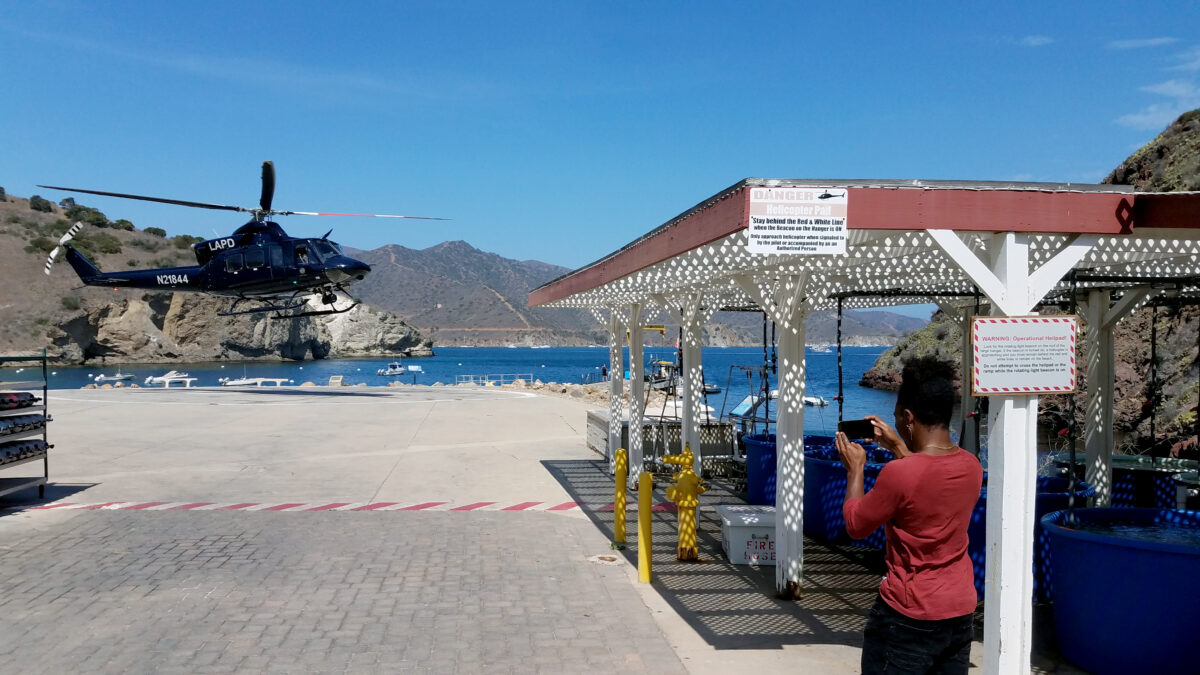
Since 1974 the USC Catalina Hyperbaric Chamber has acted as an emergency medical facility primarily used for the recompression and resuscitation of scuba divers across Southern California. As one of the only two chambers in the entire state, the USC Catalina Hyperbaric Chamber is fully manned and equipped at all times. In addition, the chamber is tested almost daily by rotating groups of volunteers and staff members to not only ensure the upkeep of the chamber, but to also maintain the knowledge and skills of those operating it. This is so that at a moment’s notice the station can be ready to operate the chamber in the event that a diving accident such as Decompression Sickness or Air Embolism occurs. For those who are unfamiliar, Decompression Sickness, otherwise known as the “Bends,” can appear when nitrogen that has been dissolved in the blood from high pressure forms bubbles as pressure is rapidly decreased. This typically happens when a diver ascends too fast for the nitrogen to dissipate. Air Embolisms on the other hand are when locked gas expands and ruptures lung tissue (pulmonary barotrauma), leading to gas bubbles entering and blocking the blood stream. Air Embolisms tend to happen when a diver holds their breath upon ascent to the surface.


A hyperbaric chamber can be used to help remedy these issues after they occur by using highly condensed and controlled air pressure to imitate the pressure in as much as 165 feet of seawater (fsw). While at depth the patient breathes through a mask typically containing 100% oxygen. This combination of high pressure and increased oxygen levels helps shrink bubbles and dissipate nitrogen in the system, ultimately reversing potential internal damage. Afterwards, to avoid any bubbles from reforming upon ascent, the controlled air pressure is gradually reduced with evenly measured increments of time depending on the initial depth, to ensure that the patient reaches regular atmospheric pressure in the safest manner possible. In some cases, hyperbaric medicine has proven to be 77% effective in helping to heal patients and has been crucial in saving the lives of those in diving related accidents. However, without proper recompression treatment, these issues can lead to permanent disabilities, severe injuries and even death. That is part of the reason why I came to Catalina. I believe it is part of my responsibility as a future leader in the diving world, to learn not only more about the risks of diving but the science behind how things like hyperbaric medicine work to help mitigate those risks.
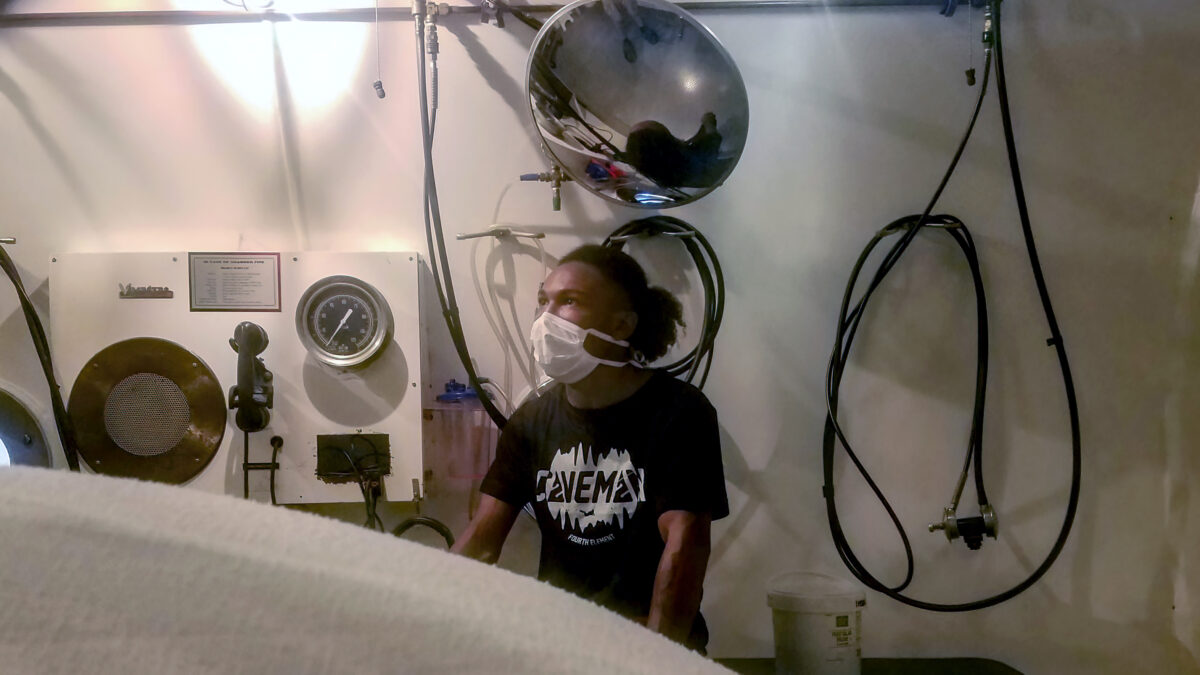
With that being said, sometimes there is no better way to learn than through firsthand experience! Don’t worry– I didn’t jump in the water and get myself injured by exceeding my NDL or anything like that, but thanks to Karl I did get to go on a quick dive in the chamber! I was curious to see what it would be like to go on a dive with no water and what it looked like in the chamber. Before getting in, though, I was told to take off any jewelry or flammables and was provided safer footwear as a precaution to prevent any potential sparks or hydrocarbons from igniting in the more oxygen-rich air of the chamber. After I did that, I then got to step into the giant blue 25-feet long and 9 feet in diameter cylinder. Once inside, I could see that the chamber was divided into two rooms. The front room was smaller, empty and could be independently pressurized so that physicians and staff could be let in and out of active treatments for quick assessments. The larger room was situated with a slew of equipment, two hospital beds, and had enough space to fit about four people.

Once I had entered the second room and the door was secured behind me, the staff proceeded to take me down to 60 ft. Prior to getting in, Karl had given me two bottles, one with the cap on and one with the cap off, to take with me so that I could see with my own eyes how the pressure in the chamber was being manipulated. On my descent I could feel the pressure around me (mostly in the form of heat) but I could also see the capped bottle as it slowly began to get crushed under the force of the air alone. While at depth I then switched the cap on the bottles, closing the one that that had remained open and opening the one that was crushed. On my ascent I could then see the opposite taking place as the air expanded in the now closed bottle, making it look like it would explode. It got so turgid that when I finally came out of the chamber, I half expected the cap to pop off like a champagne bottle. Thankfully, though, when I began to twist it off, the built-up pressure simply eased out. Phew! Once I was out, I thanked the staff that monitored my progress in the chamber and Karl for the bottles. As a more visual learner, it brought home all the things I had studied about how pressure works while diving underwater. Still, while being under pressure out of water was pretty neat, it was time for me to jump back into the water.
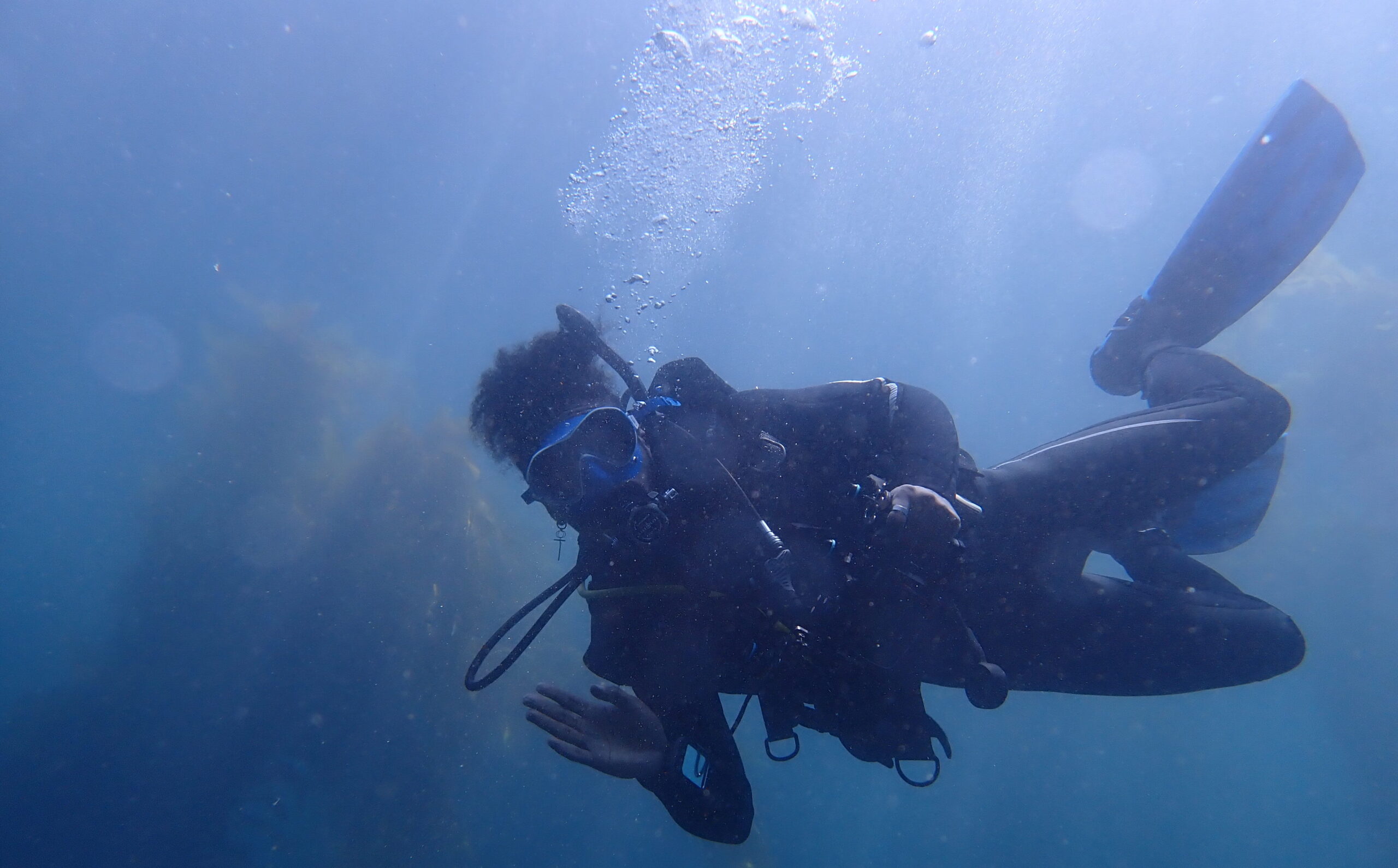
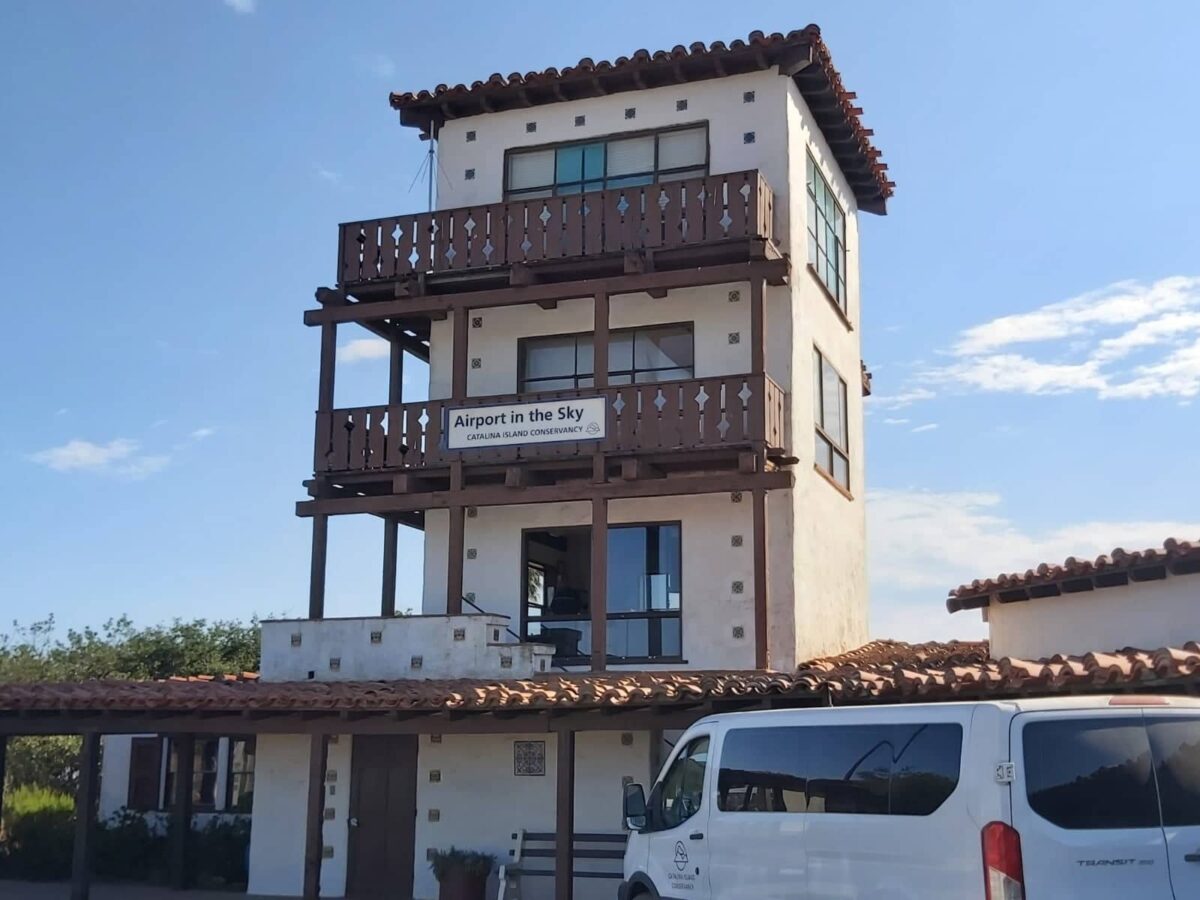
The next day Karl was kind enough to invite me on a small dive trip to Avalon which is a small city on the other side of the island. On the hour or so drive, Karl and I got to talk about his time on the island, our shared love for classical and jazz music and perhaps more importantly, the history of the island itself. Karl explained to me how Catalina is known for its roaming buffalos which were descendants of a small herd that had been introduced and abandoned on the island by a movie crew in the 1920s. He talked about the Wrigley family that owned the island, the native Tongva tribes that owned it before that and how the rural parts of the island were now mostly controlled by the Catalina Island Conservancy. We also visited the only airport on the island. The privately owned but publicly accessible Catalina airport is aptly known as the airport in the sky as it sits on the top of one of Catalina’s beautiful mountain tops.

When we arrived in Avalon I got to meet up with Larry Harris. Larry, who worked as a staff member at the Hyperbaric Chamber and had just the other day helped conduct my chamber dive, apparently also worked part time as a divemaster in Avalon and was going to lead the dive here! I had talked and hung out with Larry on several occasions, so I was happy to see his face again. On our dive I got to see the famous seaweed that Avalon is famous for and really got to use my underwater camera rig for the first time. The diving was amazing. The water was pretty decently clear. The tide wasn’t too strong. We even found an octopus! I really couldn’t thank Larry and Karl enough for the experience.

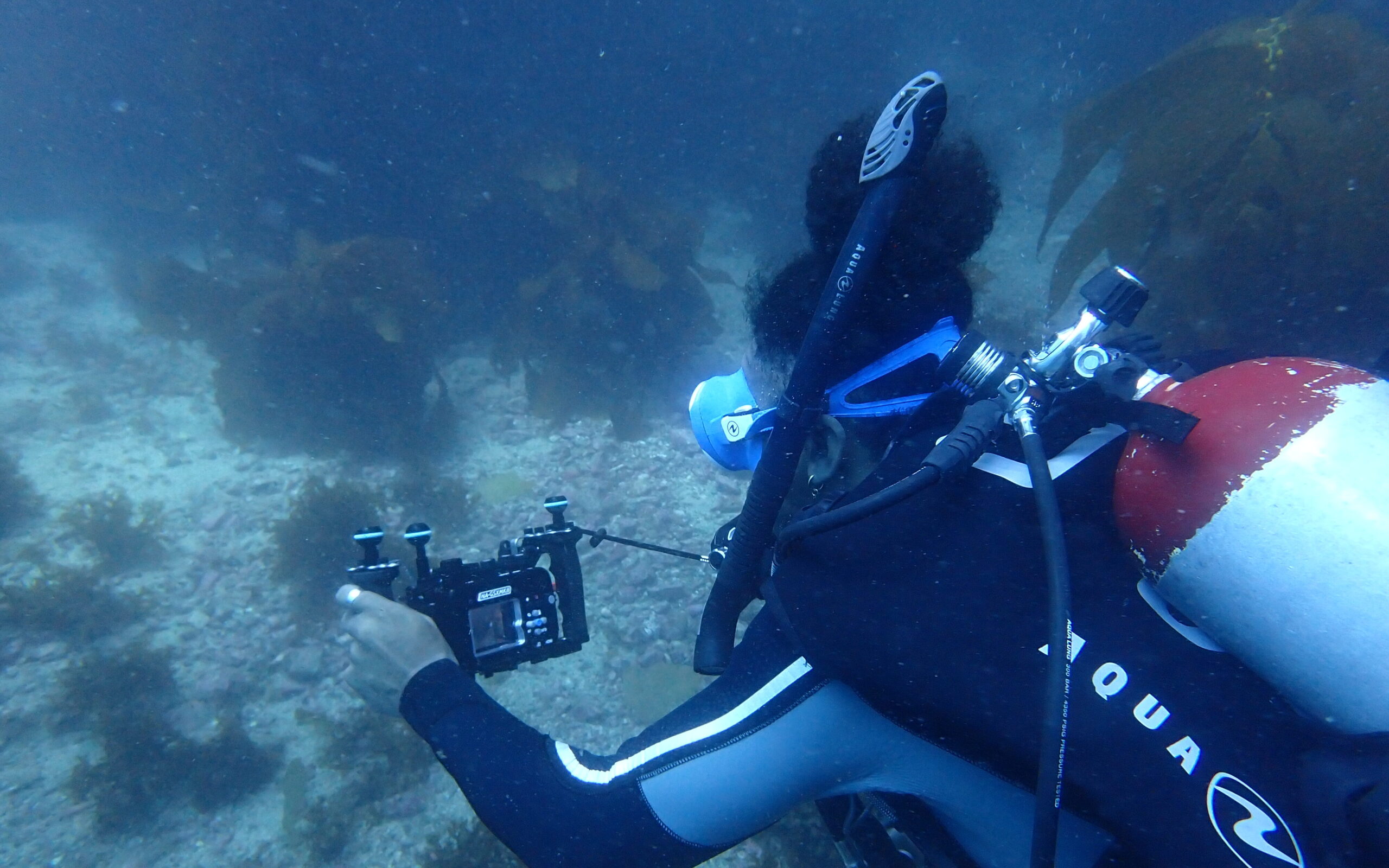
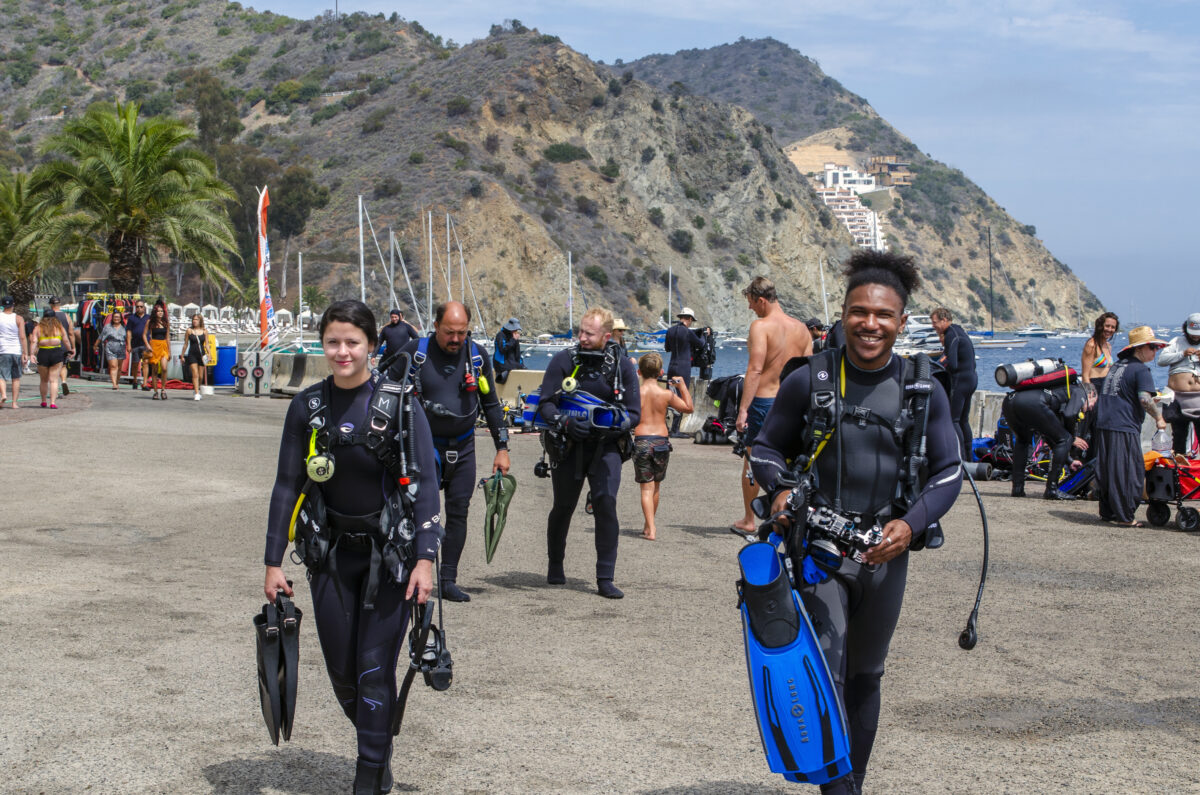
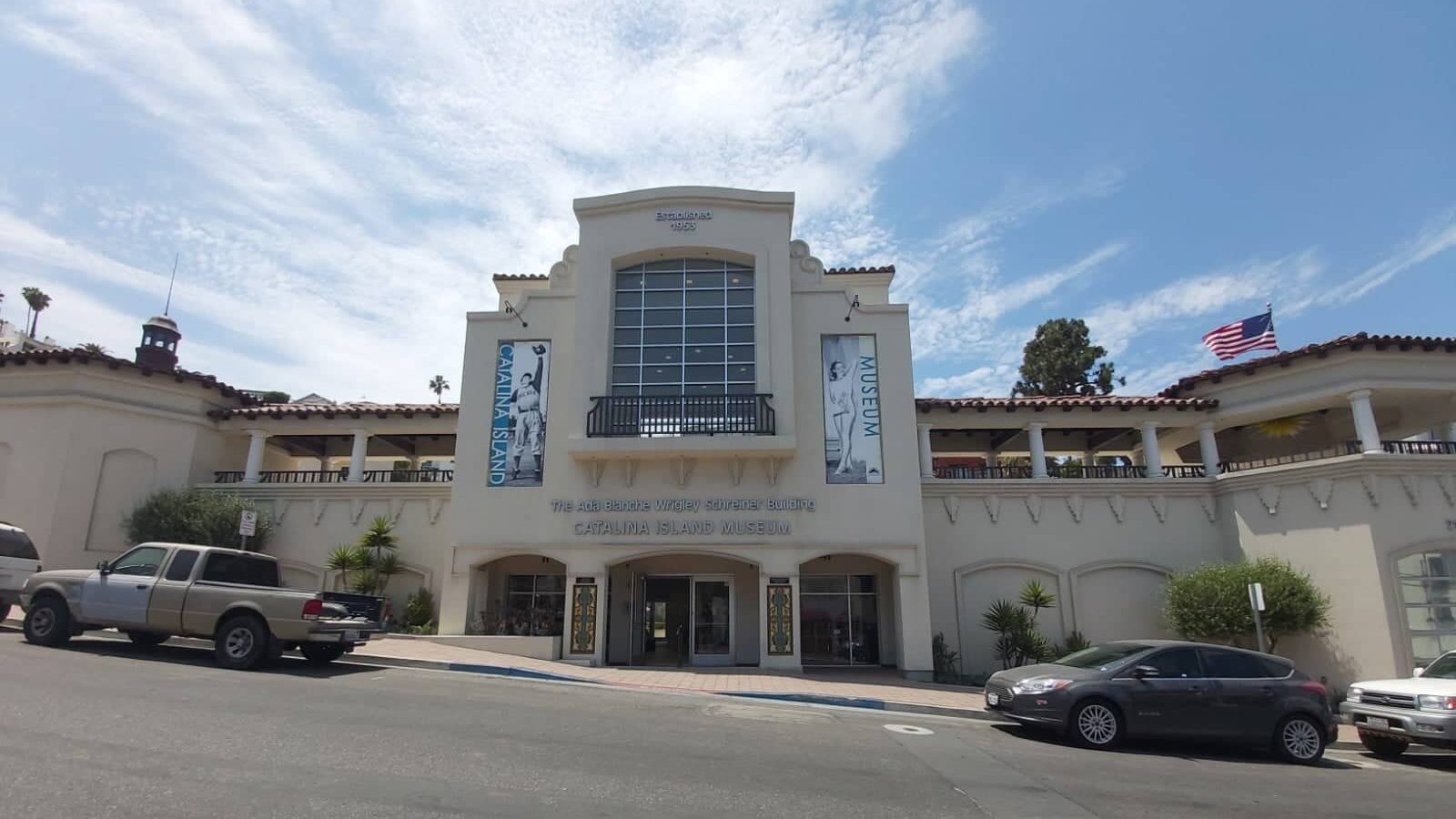
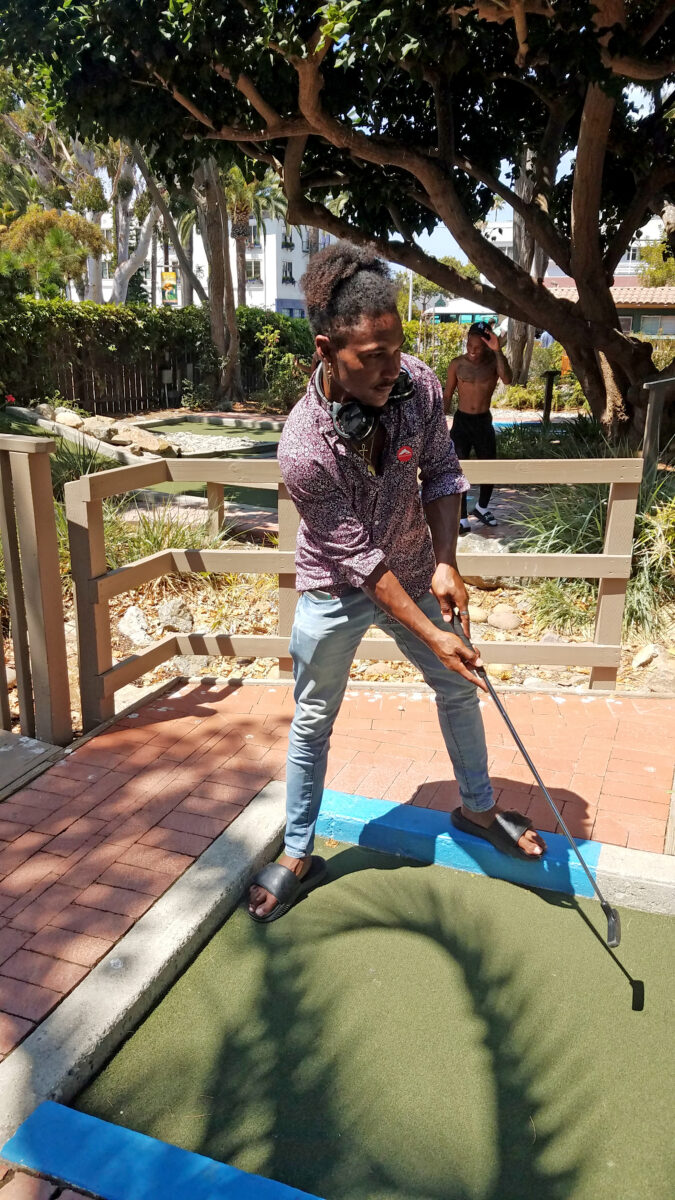
After the dive Karl and I really got to explore Avalon. We went out to eat, traveled to the museum, visited an antique dive shop, went by the store where I bought Karl some peanut M&M’s and got on the putt-putt golf course (where Karl totally kicked my butt). It was honestly a complete blast of a day but something ominous was lingering over it. As we were walking around, sirens could be heard in the distance. As they continued to blare in the background, a message came in on Karl’s phone and pretty soon he was calling someone. When he hung up, I could tell something had happened. He mentioned that there had been a dive accident and that apparently, someone who was diving where I was only a few hours prior had just been sent to the Hyperbaric Chamber.
By the time Karl and I returned, the patient had already undergone an hour or so of treatment. After a quick stop by my room, I headed down to the chamber to observe as well as to help out in any way I could. I entered the chamber shed and could see that while things were much more serious, the process was essentially the same as I’d seen before. However, this time, instead of me being inside the chamber, I was going to be monitoring and doing things on the outside. As we took the patient through the treatment the volunteers, staff members and even the physicians were happy to explain and show me what they were doing, all the while keeping tabs on the patient and their own responsibilities. It was a masterclass in multitasking, and I appreciated the time they were willing to take to explain things to me as we went. Once I started to understand more about what was going on, I was soon able to fill out data sheets and call out times. I truly became part of the team as the night went on and I was elated to be able to help in whatever way I could. The treatment lasted well into the night and even into the next morning and I stayed until the last moments. Upon hearing the good news the next morning, that the patient would be ok, I thought about how it was simply incredible to see the effort and seamless teamwork of everyone involved. I was truly proud of myself and happy that I could be there. Though it was not a situation I would wish upon anyone, it was extremely inspiring and helpful for me to see how things were done firsthand and in a real emergency.

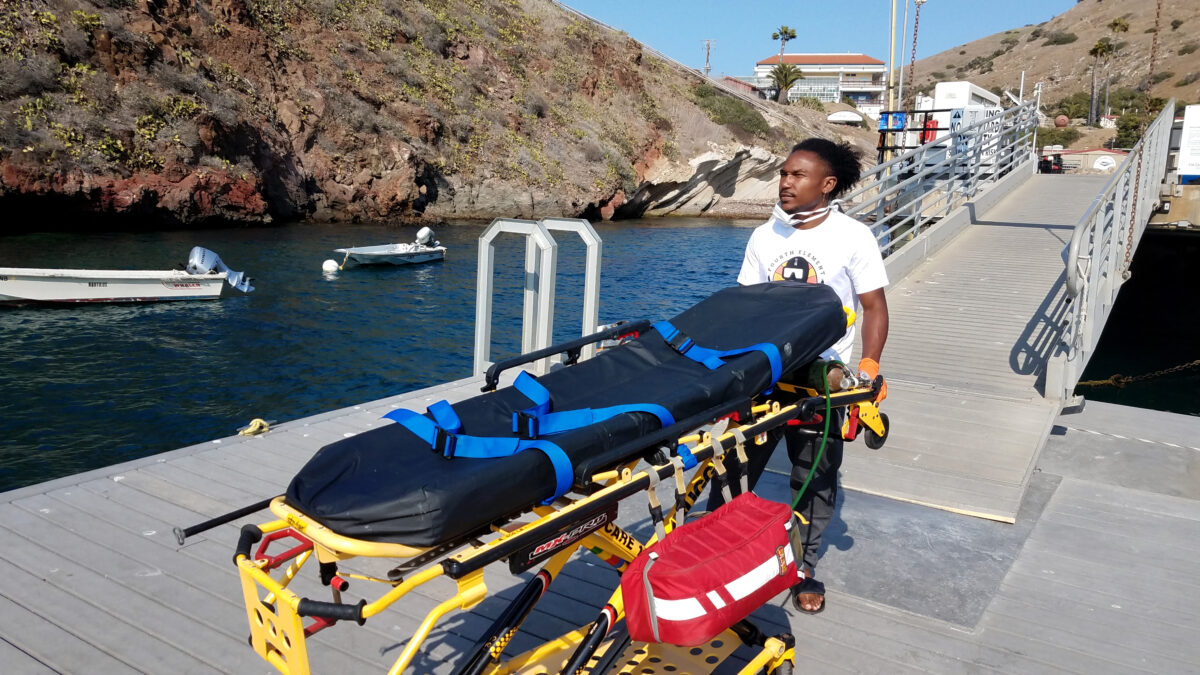

After such an intense and thrilling experience I knew I wanted to learn more about how to actually operate the chamber. So for the next few days I asked Karl help teach me. We went to the chamber and did some training. Karl took me step by step though the directions and whenever I turned a switch or a knob, he helped me understand what I was doing and why I was doing it. It was cool to know that I was operating such an impressive piece of machinery, but it was also challenging in some respects as well. Paying close attention to the different dials and the micromanagement of movements as you operate the valves requires a lot of patience, precision and vigilance. I was happy to hear from Karl that I was doing better at controlling the pressure in the chamber than most other first timers. It gave me such insight and it taught me even more about the intricacies of how the chamber works.


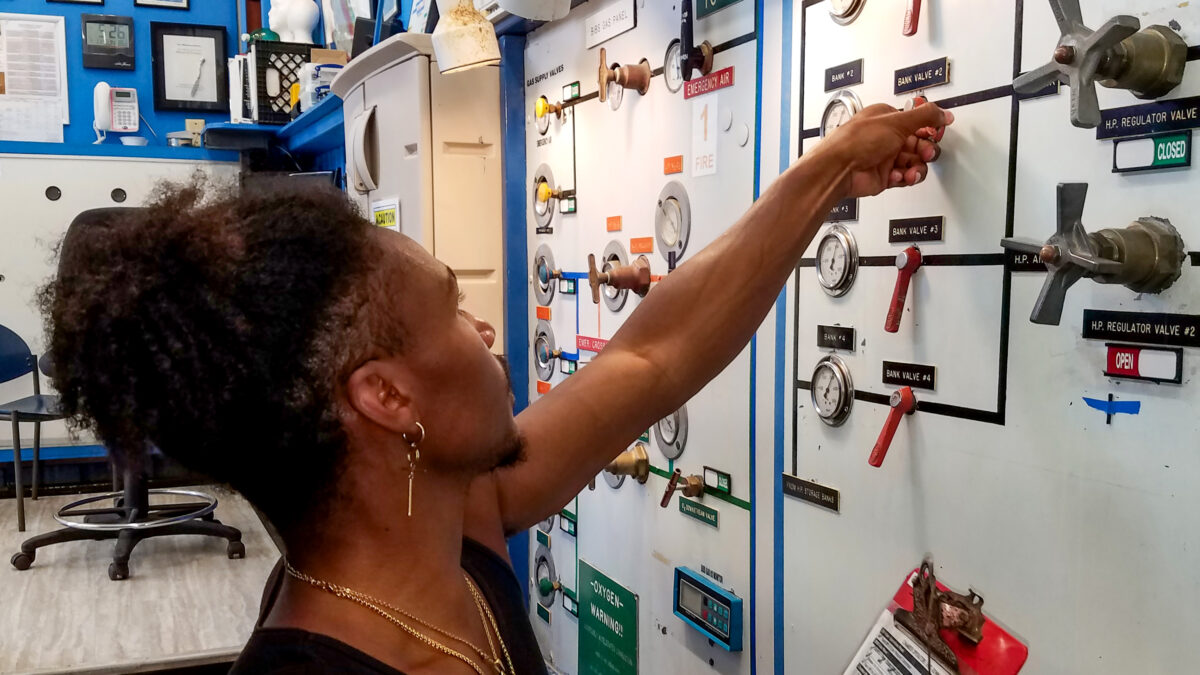
My last few days on Catalina were just as fun and eventful as the first few. I got to go hiking up on the
nearby mountain, do some snorkeling with my camera, and sneak in on some of the new students’
research projects. That’s not to mention all the amazing things that Karl invited me to do. I’m very
grateful to him for all of his support and for making sure that I got to do as much as possible not only in
an educational capacity but with recreational things, too, like kayaking through the volcanic caves
bordering the research station or watching fun Action/Sci Fi oldies and newbies. Overall, my time spent
on Catalina Island was invaluable. Every moment was filled with something special that I will take with
me for the rest of my life. I hope that, in time, anyone (especially East Coasters and Mid-Westerners!)
interested in the history of the island, marine science, great diving or hyperbaric medicine will visit
Catalina and discover what a magical place it is, just like I did.

